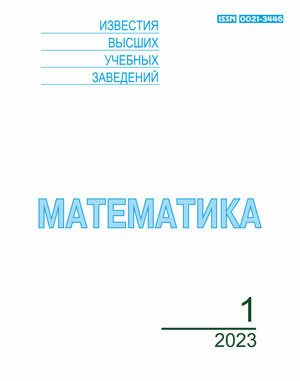
«Russian Mathematics» is a monthly scientific and theoretical journal. It contains articles on mathematics and mechanics with new mathematical results as well as reviews of the modern state of actual mathematical problems, which are interesting for a wide circle of specialists in mathematics and mechanics.
Brief communications containing the main results without proofs are also published in the journal. In this case, together with a brief communication the authors send their complete text with all the proofs. All brief communications are received as submissions from the members of the editorial board of the journal, due to this fact authors should contact one of the members of the editorial board. After a brief communication is published, it is still possible to submit the complete text of this article to another journal with a necessary reference to the published brief communication.
The journal reviews all the submitted materials, which should be appropriate to the journal’s subject, in order to have their expert assessment. All reviewers are acknowledged specialists in topics of the submitted materials.
Current issue
The paper investigates the asymptotic properties of a nonparametric estimator of the survival function of a random response in a regression model when the observations are subject to partially informative random censoring from the right.
In this paper, a Cauchy problem for an integro-differential equation with fractional Riemann-Liouville derivatives is studied. For the given problem, based on the Lebesgue space of functions summable with an arbitrarily fixed degree, a pair of spaces of the sought elements and right-hand sides is proposed, in which the problem is correctly posed according to Hadamard. In this pair of spaces, a generalized polynomial projection method for solving the problem is proposed and its theoretical and functional justification is given, and also an estimate is given of the rate of convergence of the approximate solution of the equation under consideration to its exact solution.
In this paper, the attractors of iterated function systems (IFS) consisting of two improper similitudes of the plane are investigated. The attractor of such IFS is either a connected or completely disconnected set. Sufficient conditions are found under which the attractor of such an IFS is a connected set. For an arbitrary IFS, sufficient conditions are obtained under which its attractor is a Cantor set. The main goal of the present work is to investigate the attractor Aa of two plane improper similitudes of the plane fi(z) = az, f2(z) = a(z — 1) + 1, a, z G C, 0 < |a| < 1. It is shown that Aa is one of the following sets: a segment, a Cantor set in a segment, a parallelogram, a Cantor set in a parallelogram. The Hausdorff dimension of the attractor Aa is calculated. Let M be the set of all vaiues of the parameter a for which the attractor Aa is connected. By analogy with Barnsley and Harington, we call M the Mandelbrot set. It is shown that, unlike the case of proper similitudes, the Mandelbrot set M for a pair of improper similitudes of the plane has a simple structure. Examples of attractors from the considered classes of IFS are presented.
Let X and Y be metrizable spaces. A map X —> Y is called topologically uniformly continuous, if for every admissible metric р on X there is an admissible metric a on Y such that for the metric spaces (X, p) and (Y, a) the map (X, p) —^ (Y, a) is uniformly continuous. In this article such maps are investigated. As the main result, it is shown that, in a certain sense, topologically uniformly continuous maps are close to perfect maps.
New fixed point approach based on certain topological properties is applied on the Vlasov equation to find classical non-negative solutions. This approach allows finding at least one solution and at least two solutions. It is shown how to apply this approach to the problem of finding classical non-negative solutions of the Vlasov equation.
In this paper, systems of semilinear differential inclusions of fractional orders are studied. It is assumed that the linear parts of inclusions are represented by Hille-Yosida operators in Banach spaces. The nonlinear parts of inclusions are multivalued Caratheodory type maps, depending on time and a finite set of functions. To study the problem of the existence of solutions to such a system, the theory of fractional mathematical analysis, the theory of generalized metric spaces, and also the theory of topological degree for multivalued condensing maps are used. We present a multivalued resolving operator for this system and describe its properties. It is shown, in particular, that this multioperator is condensing with respect to a special vector measure of noncompactness. This makes it possible, using some fixed point theorems for the specified multioperators, to prove local and global existence theorems for integral solutions of a given system. In the latter case, the compactness of the set of such solutions and the upper semicontinuous dependence of the set of solutions on the initial data are also justified.
We study fields over which every matrix can be represented as a sum of two potent matrices and a nilpotent matrix. In particular, it is shown that over a field P every matrix can be represented as a sum of two idempotent matrices and a nilpotent matrix exactly when either P = F2, or P = F3.
Quasi-discrete and п-projective modules are important and well-studied classes of modules, whose definitions are dual to the equivalent characterizations of the notion of a quasi-continuous module. In this paper, we introduce and study new classes of modules that also serve as dual concepts of quasi-continuous modules.
In R. Downey’s 1998 survey, the question was posed: describe order properties P such that for any low linear order L, if P(L) holds, then L has a computable copy. This paper shows that the property of being scattered is not such a property. Namely, a low scattered linear order of rank 2 with no computable copy is constructed.
ISSN 2076-4626 (Online)




























